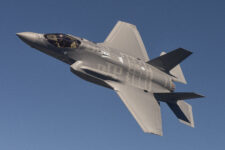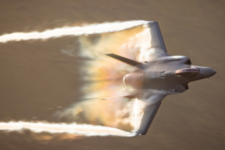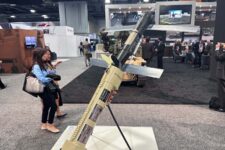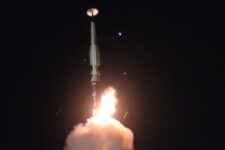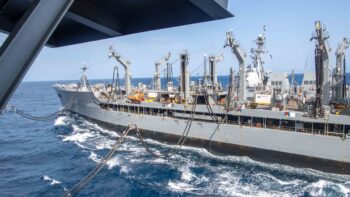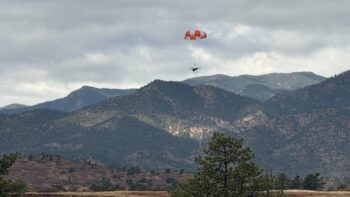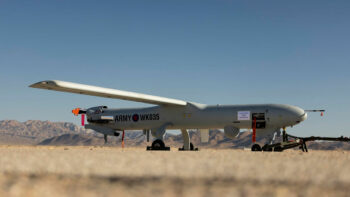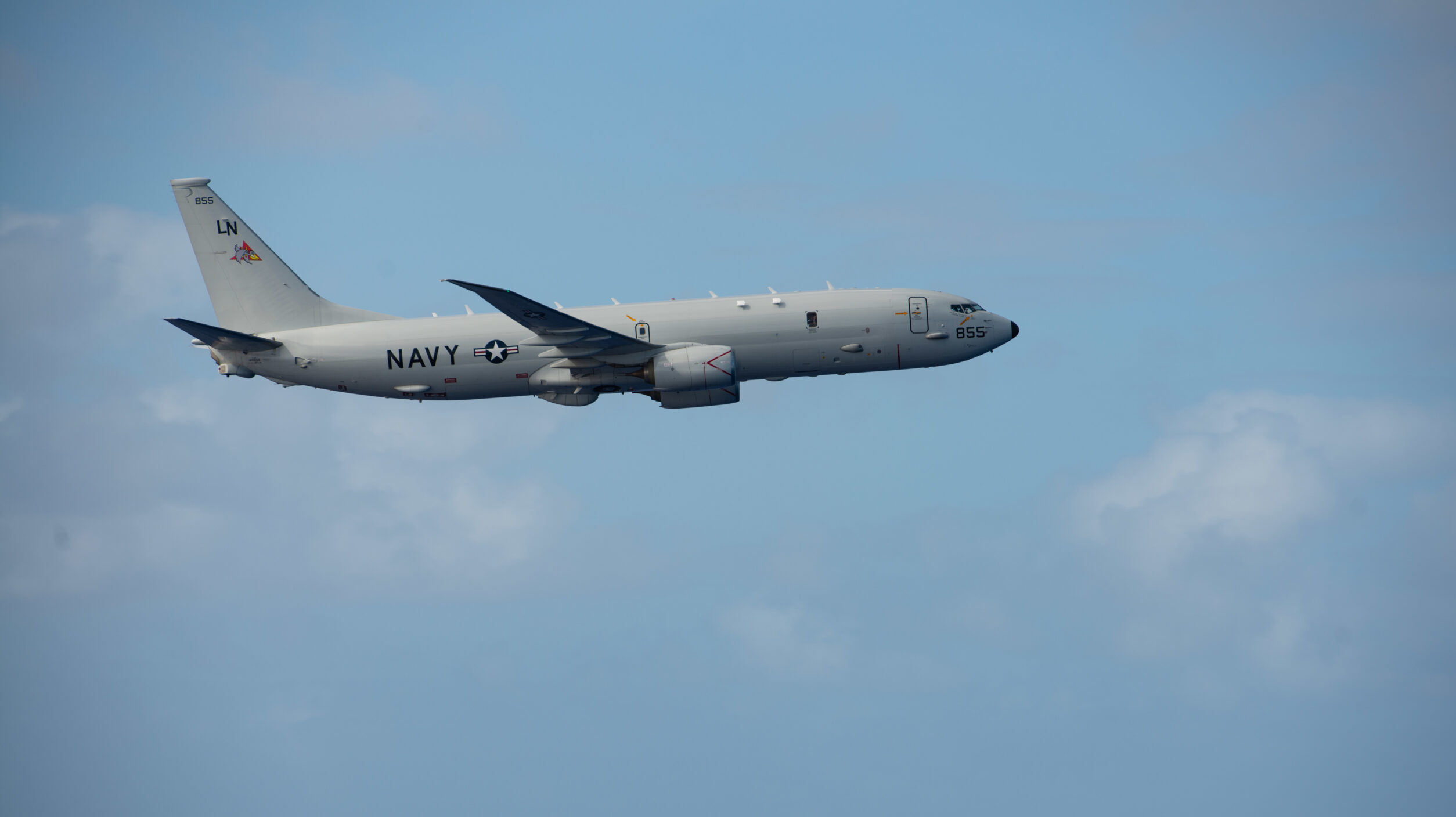
A P-8A Poseidon from the “Pelicans” of Patrol Squadron (VP) 45 flies by the aircraft carrier USS Nimitz (Photo: US Navy)
BELFAST — Despite France not yet “reaching out” to Boeing about buying P-8 Poseidon Maritime Patrol Aircraft (MPA) to replace its navy’s aging Atlantique 2 (ATL2) MPA fleet, the manufacturer is calling on decisionmakers to keep an open mind to the American defense giant’s offering.
Paris appears publicly committed to working with European firms to develop the ATL2 replacement, but Tim Flood, Boeing vice president of international business development told Breaking Defense that hypothetically speaking, there’s a case to be made for switching lanes.
“I use the France example more as a kind of hypothetical, [because] as far as it’s concerned right now, I mean, France is not reaching out to Boeing specifically,” Flood said in an interview days before top European military and industry officials descend on Germany for the Berlin Air Show. “We’ve certainly discussed that informally with the French customer. They’re aware of the P-8 capability. They’re aware of where we are at from a program perspective. My point would be just to continue to encourage the French to not discount P-8 from broader considerations when they look at recapitalizing the Atlantiques.”
France has already linked arms with European manufacturers Airbus and Dassault, after the French procurement arm (DGA) in December 2022 awarded each company contracts, each valued at €10.9 million ($11.8 million), to conduct 18 month architecture studies of a future MPA (dubbed Patmar) based on their respective A320neo and Falcon 10X aircraft.
When sharing news of the contract awards the DGA also appeared to rule out US companies from consideration, stating, “These solutions must remain open to cooperation with other potentially interested European partners.”
France expects to formally launch the next generation MPA acquisition in 2026 and have the new aircraft in service between 2030 and 2040.
Complicating matters is the uncertainty surrounding France’s commitment to the Maritime Airborne Warfare System (MAWS) effort with Germany, launched in 2017 to develop a joint future MPA to replace the ATL2 and P-3C Orion. The status of that effort is unclear, especially after France’s unilateral move to go ahead with the architecture studies, converging on sensor technology, logistics based AI and future anti-ship weapons.
Amid those permutations, Boeing hopes that the P-8 still can be considered as an alternative solution, disrupting the push for a next generation MPA. The plan, should France eventually decide to change course would be to offer the P-8 in collaboration with French suppliers.
Flood said Boeing’s previous work with a variety of local manufacturers, including Airbus and Lufthansa, to sustain German orders for 60 CH-47F Chinook heavy-lift helicopters and 8 P-8 aircraft, could be an example for a joint French P-8 effort.
One particular selling point, in Flood’s mind, is cost.
“Both companies [Airbus and Dassault] could certainly produce a pretty nice solution off a legacy A320, or a Falcon 10X for example, but at what cost?” he said. “Look at the US Navy programme to develop the P-8. They spent around $7 billion of R&D funds to actually just develop the plane not produce it, just develop, test it and get into a production ready platform. So that’s the kind of figure that France would need to invest in an indigenous capability.”
The French Navy operates 22 ATL2 aircraft out of Lann-Bihoué naval air station, which are used for anti-submarine warfare, anti-ship warfare, intelligence gathering and ground troop support missions, according to the DGA.
Under an effort stretching back to 2013, a last of 18 aircraft is expected to be upgraded to Standard 6 by 2025, involving integration of Thales-made Search Master radars, WESCAM optronic balls, new Dassault navigation consoles and other Service industriel de l’aéronautique (SIAé) tactical display consoles.
P-8s Soon To Join German Fleet
Elsewhere in the interview, Flood said Boeing expects the first German P-8 to be delivered next year, two years ahead of Berlin taking delivery of its first CH-47F helicopter.
“Germany has demonstrated a real commitment to modernization of the military, cemented by the €100 billion [$108 billion] injection into the defense budget to accelerate much needed upgrades, modernization and procurements,” he said. “We’ve seen the benefits of that with both the Chinook and P-8 procurements.”
Further afield, he said that the P-8 stands as a “potential solution” to replace four Danish CL-604 Challenger aircraft, used for surveillance, search and rescue and VIP transport missions.
“They’ve got a lot of area to cover, both the local area plus Greenland and the Faroe Islands, so … the high north and Arctic security is paramount,” added Flood.
Denmark launched a “number of analyses” as part of a first supplemental defense agreement in January, said a Danish Ministry of Defence spokesperson.
“Among those, is an analysis on transport capabilities which will explore future possible replacement capabilities to the CL-604. When finalized, the analysis will be subject to political discussions. Consequently, it is too early to speculate in the exact approach and timeframe.”
Meanwhile, Flood said that during the Berlin Air Show, Boeing “would like to” hold discussions with a “variety of customers” including Germany relating to the T-7 trainer.
“It is a perfect solution to address what is, quite frankly, a pretty urgent need to train pilots, as all these nations like Germany are buying high-end fighters like the F-35,” said Flood.
Boeing will also concentrate on F-15EX customer discussions at the show, after the manufacturer revealed in September 2023 that it is interested in selling the aircraft to Poland to fulfil an air dominance requirement.
Boeing faces competition on that front from aircraft including the F-35 and Eurofighter Typhoon.
